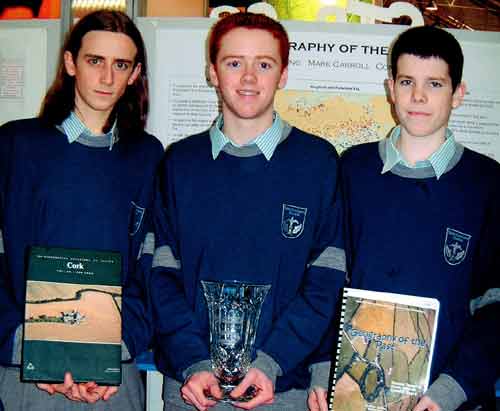| 2004 |

|
YEAR BOOK |
Col�iste Choilm, Ballinacollig, Cork
|
Geography of the past
|

We contacted the Cork Archaeological Survey and they agreed to give us a copy of the recorded ringforts for the barony of Muskery. Once we had obtained the records, we entered the required information for each site, e.g. height above sea level, national grid reference, land use and condition, into a Microsoft Access database, which we constructed ourselves.
After this stage was completed, we asked the database questions. We wanted to find out the relationship between survival of the site and either land use or altitude. For example, we asked the database to find all the sites between 500 and 600ft above sea level, which were in tillage and had been levelled. With information like this we were able to compare the patterns of location and survival for fulachta� fia and ringforts.
We then used GIS (Geographical Information Systems) to map this information. We used the maps to show the relationship between sites at different altitudes, land uses and conditions.
We discovered that 8% of fulachta� fia showed no trace existed, with a further 32% showing as a spread, and 60% surviving as a mound. 54% of sites were mounds (visible mound) in pastureland, while 46% were spreads (flattened due to farming) or no trace could be found. Of the total number of ringforts analysed, 22% were levelled (flattened), while 78% survived. In pastureland 28% of ringforts were levelled, while 72% survived. In tillage, 69% of ringforts survived, while 31% were levelled.
To conclude, we discovered that altitude is not a factor in the survival rate of fulachta� fia and that farming practice is the most significant factor in their survival. Fulachta� fia survive more in pastureland than in tillage. Land use is not a factor in the survival of ringforts, and they have a greater chance of surviving at higher altitudes.
Mark Carroll, Daniel Fleming & Connor Barry entered their project in the Intermediate Group Section in the Social and Behavioural Sciences Category at the EsatBT Young Scientist & Technology Exhibition in January 2004. They won a Special Award � the Dell Student Award. Their teacher was Ms Norma O'Keefe.
| This article was sponsored by Dell Computer Corporation |
|---|